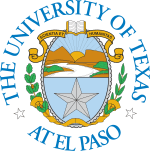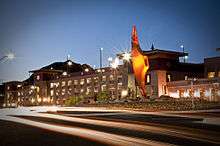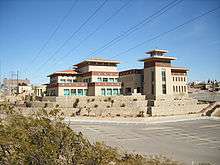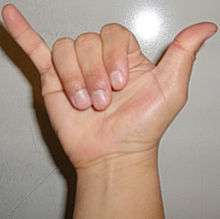University of Texas at El Paso
Coordinates: 31°46′12″N 106°30′18″W / 31.77000°N 106.50500°W
 | |
| Motto | SCIENTIA ET HUMANITAS |
|---|---|
Motto in English | Science and Humanities |
| Type | Public, Hispanic-serving institution |
| Established | 1914 |
| Endowment | $151,200,713[1] |
| President | Diana Natalicio |
Academic staff | 1,309 (Fall 2012)[2] |
Administrative staff | 1,511 |
| Students | 23,003[3] |
| Undergraduates | 19,217[3] |
| Postgraduates | 3,532[3] |
| Location | El Paso, Texas, U.S. |
| Campus | Urban, 366 acres (1.5 km2) |
| Colors |
Orange, Blue, & Silver[4] |
| Athletics | NCAA Division I FBS – C-USA |
| Sports | 16 Varsity Sports Teams |
| Nickname | Miners / Lady Miners |
| Mascot | Paydirt Pete |
| Affiliations |
UT System APLU |
| Website |
www |
 | |
The University of Texas at El Paso (UTEP) is a public research university in El Paso, Texas, United States. The school was founded in 1914 as the State School of Mines and Metallurgy,[5] and a practice mineshaft survives on the mountainous desert campus. Following a reorganization of the University of Texas in 1920, the school was renamed the College of Mines and Metallurgy of the University of Texas.[5] It became Texas Western College of the University of Texas[5] in 1949, and The University of Texas at El Paso[5] in 1967. UTEP is part of the University of Texas System.
UTEP is the second-largest university in the U.S. to have a majority Mexican American student population (about 80%).[6] The campus features a collection of buildings in the Dzong architectural style. It is located on hillsides overlooking the Rio Grande, with Ciudad Juárez in view across the Mexico-U.S. border.
History

On April 16, 1913, SB 183 was signed by the Texas governor allocating funding for a new institution, making it the second oldest academic institution in the University of Texas system. The school officially opened on September 28, 1914, with 27 students in buildings belonging to the former El Paso Military Institute on a site just adjacent to Fort Bliss on the Lenoria Mesa. By 1916, enrollment had grown to 39 students, including its first two female students, Ruth Brown and Grace Odell. On October 29, 1916, a devastating fire destroyed the main building of the school, prompting its relocation. In 1917, the new school facility was constructed on its present site above Mundy Heights, with the land donated by several El Paso residents. In a period when United States architects were designing in styles adopted especially from Europe, Kathleen Worrell, wife of the university's dean, was attracted by photographs of the Kingdom of Bhutan in a 1914 issue of National Geographic magazine, which showed the dzong architecture style of its Buddhist monasteries.[7] The resemblances between the local terrain and mountainous features of Bhutan inspired her to propose designing early buildings of the mining school in the dzong style. Liking its distinctiveness, administrations have continued to choose that style for additional facilities, including the Sun Bowl football stadium and parking garages. Dzong (fortified religious and administrative centers) has characteristics such as sloping sides, markedly overhanging roofs, and bands of colored decoration.[8]
In 1919, the school name was changed to the University of Texas Department of Mines and Metallurgy, when it was made a branch of the University of Texas by act of the Texas State Legislature. In 1920, it was changed to the Texas College of Mines and Metallurgy (TCM). TCM's students painted a large "M" for Miners on the Franklin Mountains in 1923; this was later moved to a site adjacent to the Sun Bowl Stadium in the 1960s where it remains today. The school's name was changed again in 1949, to Texas Western College of The University of Texas (TWC).
Notable events at TWC include the training in 1961 of the nation's first Peace Corps class, the construction of Sun Bowl Stadium in 1963, and the winning of the NCAA Men's Basketball Championship in 1966. In 1967, following the establishment of a reorganized University of Texas System, the school took on its current name: The University of Texas at El Paso. While the 1967 law designated "U.T. El Paso" as the school's official abbreviated name, the school is more commonly referred to by its trademarked name of "UTEP."[9]

The school has had achievements in academic and sports areas. In 1969, UTEP won the first of seven NCAA Men's Cross Country Championships. In 1974, UTEP's first doctoral degree program in Geological Sciences was approved. Also in 1974, UTEP won the first of seven NCAA Men's Indoor Track and Field Championships. In 1975 UTEP won both the NCAA Men's Outdoor and Indoor National Championships. UTEP is only one of a handful of universities to win at least 21 NCAA national championships in multiple sports.
The campus expanded in 1976 with the completion of the Engineering-Science Complex. That same year, the College of Nursing was founded. In 1977, the Special Events Center (now the Don Haskins Center) was built, featuring a 12,000-seat capacity for sporting events, live concerts, and other performances. An expansion of Sun Bowl Stadium followed in 1982, increasing its capacity to 52,000. The six-story University Library opened its doors to the public for the first time in 1984.
In 1988, Diana Natalicio became UTEP's first woman president and is today the longest-serving still sitting president of a major public research university. The next year, UTEP's second doctoral program was approved (in Electrical Engineering). Doctoral programs in Computer Engineering, Psychology, and Environmental science and engineering followed in 1991, 1993, and 1995, respectively. The university's cooperative Pharmacy and Nursing doctorate programs began in 1996 and 2000, respectively. A Biological Sciences doctorate program was started in 1997 and a History doctorate followed in 1999. Doctoral programs in International business, Civil engineering, and Rhetoric and Composition were started in 2003.
Texas Western/UTEP coach Don Haskins, who compiled a 719–353 record, suffering only five losing seasons, was inducted into the Basketball Hall of Fame in 1997 and the Special Events Center was renamed the Don Haskins Center. He retired from coaching in 1999, and died in 2008. The entire 1966 UTEP team was inducted into the Hall of Fame in 2007.

In 1999, UTEP launched its MBA online degree program. It was designated as a Comprehensive Doctoral/Research-Intensive University by the Carnegie Foundation the following year. In 2002, the $11 million Larry K. Durham Sports Center opened and the Sam Donaldson Center for Communication Studies was established. The Academic Services and Biosciences buildings as well as the Engineering-Science complex in 2003. UTEP celebrated its 90th anniversary the next year with the Miners football team going to the Houston Bowl, and the men's basketball team made its 15th NCAA Tournament appearance.
In 2005, UTEP moved to Conference USA from the Western Athletic Conference and was classified "RU/H" by the Carnegie Foundation.
Mike Price was hired as football coach in 2003 and announced his retirement in November 2012.[10] On December 10, 2012, it was announced that Sean Kugler would be taking over as the new UTEP football coach.[11]
Since 2010, Tim Floyd has been the head basketball coach. He was a protege of Don Haskins and is a former coach at the University of New Orleans, the NBA's Chicago Bulls and New Orleans Hornets, and the University of Southern California.
Academics and research
| University rankings | |
|---|---|
| National | |
| Forbes[12] | 491 |
| U.S. News & World Report[13] | Not Rated |
| Washington Monthly[14] | 10 |
The University of Texas at El Paso is subdivided into seven colleges, each of which offers a variety of degree programs including undergraduate, graduate, and post-graduate.
UTEP offers 71 undergraduate degrees, 76 master's-level degrees, and 20 doctoral degrees.[15] The university ranked, in 2006, second in federal research spending among UT System academic institutions, and in fiscal year 2006 reported $45.7 million in total research spending. From 2011-12, UTEP spent nearly $70 million in research, while it anticipates an expenditure of $76 million for the 2012-13 academic year.[16]
Leading research is currently being conducted on campus. In November 2012, it was announced that Igor C. Almeida, Ph.D., professor of biological sciences at UTEP, had developed a fully protective vaccine against Chagas disease. UTEP also holds the rights to a patent (# 5,798,392) for the use of methanesulfonyl fluoride (MSF) as a central nervous system selective cholinesterase inhibitor for the treatment of Alzheimer's disease developed by Donald E. Moss Ph.D., in the department of psychology. A Phase I human clinical trial of MSF as a potential treatment for Alzheimer's disease was recently successfully completed in Germany.[17]
Hispanic Business magazine has twice ranked UTEP as the number one graduate engineering school for Hispanics. The National Action Council for Minorities in Engineering has called UTEP "a model for other engineering institutions who say that today's minority young people from low-income families can't succeed in a rigorous math- or science-based discipline."
The National Science Foundation has designated UTEP as a Model Institution for Excellence, one of only six in the country. UTEP is one of only 11 universities nationwide to receive a $5 million Teachers for a New Era (TNE) research grant from the Carnegie Corporation.[18]
UTEP follows a semester system with a spring, summer, and fall semester annually, along with a shorter wintermester in the month of January.[19]
Campus architecture


In 1916, only two years after the school opened, the original buildings were destroyed in a fire. The school was rebuilt on its present site in 1917. Kathleen Worrell, wife of the school's first dean Steve H. Worrell, had seen pictures of Bhutanese buildings in an April 1914 issue of National Geographic. Noting the similarity of mountainous Bhutan (which is in the Himalayas) to the location of the campus, she suggested that the new buildings be in the style of Bhutanese dzongs (monastic fortresses), with massive sloping walls and overhanging roofs. This idea was enthusiastically accepted by all.
Prominent El Paso architect Henry Trost designed the first four buildings. All buildings since then have followed this style, including a fifth by Trost in 1920, and three more by his firm in 1933-1937. While the early structures only copied the general appearance of a dzong, recent buildings incorporate internal elements of the dzong form as well.
The kingdom of Bhutan has honored UTEP's appropriation of their country's style. Prince Jigyel Ugyen Wangchuk has visited the campus, and in 2009 the Kingdom presented UTEP with a hand-carved wooden temple to be erected on the campus.[20]
The "Himalayan" style of UTEP's campus made it an appropriate site for the Chenrezig Himalayan Cultural Center of El Paso, a Tibetan Buddhist facility.
School colors and logo
Since the school was established as a department of the main branch of the University of Texas in Austin, the school's colors were originally orange and white. However, in the early 1980s, Columbia blue was added so now the official colors are orange, white, and blue. When the new UTEP athletic department logo was introduced in the fall of 1999, a darker hue of blue was incorporated into the logo, as well as a silver accent to go with the customary orange.[21]
Athletics

UTEP was the first college in the American South to integrate its intercollegiate sports programs. This breakthrough was made in the 1950s. When Don Haskins became basketball coach in 1961, he aggressively recruited black players. In 1966, Haskins' Miners won the NCAA basketball championship, defeating an all-white Kentucky team in the final game. In 1966, at a time when many claimed that black players lacked the mental and emotional "necessities" to compete at a high level, the UTEP Miners coach Don Haskins put his usual starting players in the Championship game. They were the first all-black team to start in a game at that level – and to win.
This success story was retold in Haskins' autobiography Glory Road (2005), and in the 2006 movie Glory Road.
UTEP's sports programs have won a total of 21 NCAA Division I national championships.[22] UTEP is currently tied for 10th overall among schools in Men's Sports Division I championships.
- Men's basketball: 1 (1966; the only NCAA men's basketball title won by a university from the state of Texas)
- Men's cross country: 7 (an eighth title was vacated by the NCAA following the championship)
- Men's indoor track & field: 7
- Men's outdoor track & field: 6
UTEP owns the two largest venues in El Paso, Texas:
- Sun Bowl Stadium, seating capacity 51,500, opened its doors in 1963 and is currently the home to the UTEP football team and to the annual Sun Bowl game.
- Don Haskins Center, seating capacity 12,000, was built in 1976 and is primarily used by the men's and women's basketball teams. It is also known as "The Bear's Den" as well as "The Don." The arena is also used for concerts by mainstream artists.
- University Field (UTEP), seating capacity 500, was built in 1991 and hosts the women's soccer team.
- Kidd Field, seating capacity 15,000, home of UTEP Track and Field teams.
Pickaxe hand symbol

This hand symbol represents the traditional tool used by Miners, the pickaxe. This gesture is made by UTEP Miners fans when UTEP players are shooting free throws at basketball games, or any time UTEP kicks off at a football game. It was first introduced by the UTEP cheerleading squad during the 1976–77 football season.[23]
Nickname
The first reference to the nickname "Miners" is found in the February 1919 (volume 1, number 1) issue of the Prospector, the school's student newspaper. However, an earlier reference can be found in the handwritten bill (Senate Bill 183) that established the school in 1913, where the author, State Senator Claude Hudspeth, mistakenly wrote "Miners" instead of "Mines," and thus referred to the school as the "State School of Miners and Metallurgy." It is presumed that the nickname "Miners" came from the fact that the school was founded as the "State School of Mines and Metallurgy." In doing research on this project, early mention of "Ore Diggers" and "Muckers" for the nickname was found, but nothing to determine if the name "Miners" was voted upon by the student body, or if a faculty member, John W. (Cap) Kidd, chose the name. Kidd was a big booster of athletics, especially football, and in 1915, when funds were rather lean at the school, Kidd donated $800 to equip the football team, though there is no evidence other than anecdotal that he contributed this amount. He also assisted with coaching, although he was not the head coach. The present track facility on campus, Kidd Field, bears Cap Kidd's name.
School songs
"The Eyes of Texas" was adopted by the 1920 student body after the song had been "declared the school anthem for the University of Texas at Austin".[24][25]
UTEP's fight song, "Miners Fight" was also borrowed from the Austin campus.
With the estate of Marty Robbins, the UTEP Music Department in the late 1980s wrote new words to the melody of his Emmy Award-winning Country & Western hit "El Paso". This gave UTEP a fight song all its own, to a tune recognized across the nation.[26]
Notable people
Faculty
- Zuill Bailey, professor of cello, professional cellist
- Steven Best, professor of philosophy and co-founder of the North American Animal Liberation Press Office
- Jorge Gardea-Torresdey, chemistry professor and nanoparticle researcher
- Laurie Ann Guerrero, writer and Texas Poet Laureate
- John Haddox, American philosopher, Latin-Americanist
- Urbici Soler y Manonelles, Spanish sculptor
- Benjamin Alire Sáenz, writer
- Jack Vowell, political science professor and state representative from 1981 to 1995
Alumni
- F. Murray Abraham – Academy Award Best Actor winner, Amadeus
- Ana Alicia – actress
- Nate Archibald – NBA Hall of Famer, chosen as one of the Top 50 Greatest NBA Players
- Jim "Bad News" Barnes – former NBA center with New York Knicks; #1 pick in 1964 NBA Draft
- Bob Beamon – Olympic gold medalist, world record holder in track and field
- Kevin Belcher – NFL player
- Derrick Caracter (born 1988), power forward/center who played for the Los Angeles Lakers, now with A.S. Ramat HaSharon of the Israeli Liga Leumit.
- Fred Carr – Green Bay Packers Hall of Fame
- Oniel Cousins – former NFL player
- George Daney – former NFL player
- James Davidson (American football) – former NFL player
- Antonio Davis – NBA All-Star, president of the National Basketball Players Association
- Quintin Demps – former NFL player
- Sam Donaldson – ABC News veteran and former White House Chief Correspondent
- Jon Dorenbos – Philadelphia Eagles long snapper
- Dave Feitl – former NBA player
- Greg Foster – former NBA player and one time NBA champion with the Los Angeles Lakers
- Hector Guerrero – professional wrestler, performed on WWF and NWA
- Vickie Guerrero – General Manager of WWE Smackdown
- Pat Haggerty – Republican representative from El Paso County, 1989-2009
- Jack Handey – American humorist, Saturday Night Live
- Wayne Hansen – former NFL player
- Tim Hardaway – NBA All-Star, 2000 Summer Olympics gold medalist
- Idris Haron – Chief Minister of Malacca, Malaysia
- William D. Hawkins – U.S. Marine awarded the Medal of Honor posthumously during World War II.
- J. P. Hayes – professional golfer
- Johnnie Lee Higgins – National Football League wide receiver and return specialist, Conference USA Special Teams Player of the Year in 2006.
- Ed Hochuli – National Football League referee
- Thomas Howard – former NFL linebacker
- Suzanna Hupp – former Republican state representative and Second Amendment advocate
- Chris Jacke – BBA 1989, All-American place kicker, Super Bowl champion with Green Bay Packers
- Shoshana Johnson – U.S. Army Specialist, former Iraq POW
- Seth Joyner – 1991 NFL Defensive Player of the Year by Sports Illustrated, one-time Super Bowl champion
- Mia Khalifa – Adult film actress
- MacGruber – Action Man, American Hero, Military Vet, and Sax Player Played College Ball for UTEP
- Yossi Maiman – Israeli businessman[27]
- Karla Martinez – host of popular morning show Despierta America
- Don Maynard – Pro Football Hall of Fame
- Paul Moreno – former Texas Democratic State Representative, longest serving Mexican American elected official in the United States
- Halakilangi Muagututia – American football player
- Brian Natkin – former NFL tight end and unanimous college All-American
- Blessing Okagbare – Olympic and world medalist in the long jump
- John D. Olivas – first UTEP alumnus to be selected as an astronaut by NASA, member of Space Shuttle Mission STS-117 crew aboard the Atlantis
- Bob O'Rear – one of the earliest employees of Microsoft
- Estela Portillo-Trambley – poet
- John Rayborn – gridiron football player
- Nolan Richardson – former NCAA champion collegiate men's basketball head coach at the University of Arkansas
- Rubén Salazar – Mexican-American journalist
- Paul Smith – former NFL player
- W. E. "Pete" Snelson – journalist, businessman, and member of both houses of the Texas State Legislature from Midland, later worked in Austin as an educational consultant
- Charles A. Steen – geologist whose Mi Vida Mine discovery started the American Uranium Boom of the 1950s
- Billy Stevens – former Green Bay Packers quarterback
- Obadele Thompson – former 100 meters world record holder
- Tony Tolbert – three-time world champion with the Dallas Cowboys
- Susana Martinez – Incumbent governor of New Mexico
- Riley Matheson – former NFL player
- Jack Vowell (Master of Arts, 1952) – former state representative, political science professor, and construction company owner from El Paso
- Bob Wallace – former Chicago Bears tight end
- Marvin Washington – former NFL player
- Charlie West – former NFL player
- Jesse Whittenton – former NFL player
- Robert Windham – professional wrestler, performing as Blackjack Mulligan, and patriarch of a prominent wrestling family.
- Richard Crawford White – politician, served in the Texas House of Representatives from 1955 to 1959 and in the U.S. House of Representatives from 1965 to 1983.
- Jesse Whittenton – Green Bay Packers Hall of Fame
- Barron Wortham – former NFL player
- Brian Young – former NFL player
Gallery
 College of Engineering Department area
College of Engineering Department area Engineering building
Engineering building Library
Library
See also
References
- ↑ "University of Texas-El Paso | Best College | US News". Colleges.usnews.rankingsandreviews.com. 2012-11-29. Retrieved 2012-12-06.
- ↑ "First-Time Students Push UTEP to New Fall Enrollment Record -". University of Texas at El Paso. 2013-06-20. Retrieved 2014-02-14.
- 1 2 3 "UTEP Reaches All-Time Enrollment High". University of Texas at El Paso. Retrieved 18 February 2014.
- ↑ Identity Guide
- 1 2 3 4 "Official Names; UTEP Encyclopedia". Retrieved 2015-04-19.
- ↑ https://www.utsystem.edu/sites/utsfiles/documents/strategic-initiatives/fast-facts-2016/fast-facts-2016-06-15.pdf
- ↑ Napoli, Lisa. "El Paso: Bhutan's Kingly Style Reflected in UTEP Architecture". Los Angeles Times. Retrieved 5 December 2012.
- ↑ University History". UTEP Handbook of Operations, University of Texas, El Paso. Archived from the original on 23 July 2011. Retrieved 1 September 2011.
- ↑ "Official Names". UTEP Encyclopedia. December 1, 2014.
- ↑ "UTEP's Mike Price retiring after coaching for 31 years - ESPN". Espn.go.com. 2012-11-19. Retrieved 2012-12-06.
- ↑ "UTEP hires Sean Kugler as coach". ESPN. Retrieved 10 December 2012.
- ↑ "America's Top Colleges". Forbes. July 5, 2016.
- ↑ "Best Colleges 2017: National Universities Rankings". U.S. News & World Report. September 12, 2016.
- ↑ "2016 Rankings - National Universities". Washington Monthly. Retrieved September 6, 2016.
- ↑ "UTEP Facts Brochure". The University of Texas at El Paso. Retrieved 20 December 2013.
- ↑ Natalicio, Diana. "State of the University - Convocation Remarks September 2012". The University of Texas at El Paso. Retrieved 20 December 2012.
- ↑ "A randomized phase I study of methanesulfonyl fluoride, an irreversible cholinesterase inhibitor, for the treatment of Alzheimer's disease.". NCBI Resources. Retrieved 18 February 2014.
- ↑ "Carnegie Corporation Names New Teachers Program Grantees". Philanthropy News Digest. Retrieved 20 December 2012.
- ↑ "Academic Calendar". University of Texas at El Paso. Retrieved 13 December 2012.
- ↑ Soltero, Ed (January–February 2009), "UTEP's Bhutanese Campus Goes Modern", Texas Architect
- ↑ UTEP Encyclopedia
- ↑ Schools with the Most NCAA Championships Archived June 3, 2007, at the Wayback Machine.
- ↑ Learn the Miner Traditions, Chants and Fight Song
- ↑ "Spirit and Traditions - University of Texas at El Paso". utexas.edu. Retrieved 2014-01-05.
- ↑ "Songs - University of Texas at El Paso". utexas.edu. Retrieved 2014-01-05.
- ↑ "School Songs - University of Texas at El Paso". Retrieved 2014-01-05.
- ↑ "Company Overview of Merhav MNF Ltd.: Yosef A. Maiman". Bloomberg. Retrieved October 21, 2016.
External links
| Wikimedia Commons has media related to University of Texas at El Paso. |
- Official website
- UTEP Encyclopedia
- Official UTEP Athletics website
- Student Newspaper of The University of Texas at El Paso